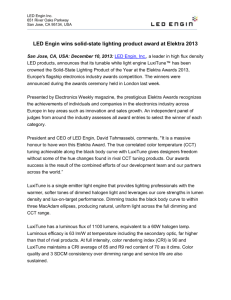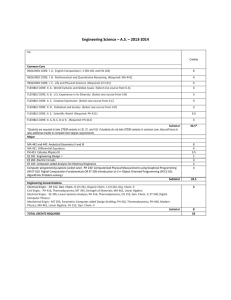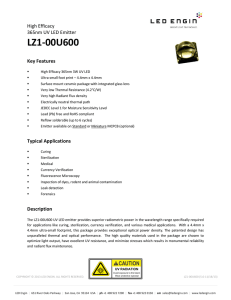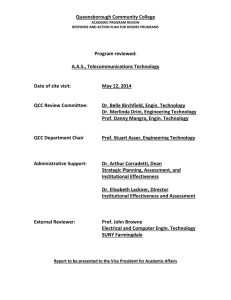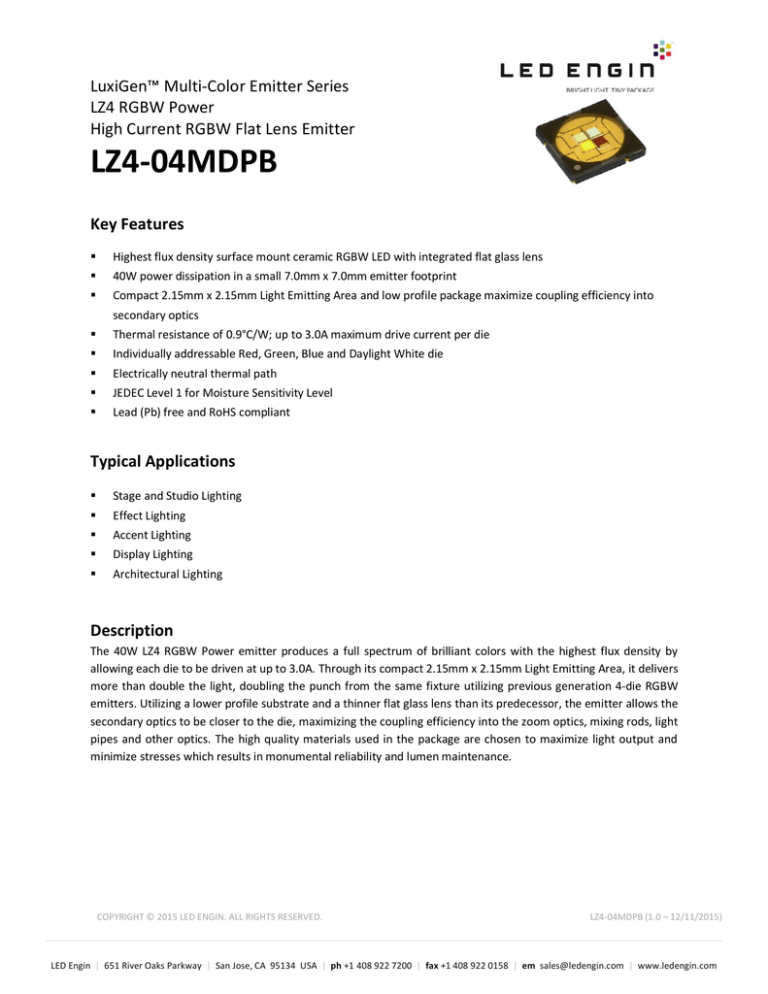
LuxiGen™ Multi-Color Emitter Series
LZ4 RGBW Power
High Current RGBW Flat Lens Emitter
LZ4-04MDPB
Key Features
Highest flux density surface mount ceramic RGBW LED with integrated flat glass lens
40W power dissipation in a small 7.0mm x 7.0mm emitter footprint
Compact 2.15mm x 2.15mm Light Emitting Area and low profile package maximize coupling efficiency into
secondary optics
Thermal resistance of 0.9°C/W; up to 3.0A maximum drive current per die
Individually addressable Red, Green, Blue and Daylight White die
Electrically neutral thermal path
JEDEC Level 1 for Moisture Sensitivity Level
Lead (Pb) free and RoHS compliant
Typical Applications
Stage and Studio Lighting
Effect Lighting
Accent Lighting
Display Lighting
Architectural Lighting
Description
The 40W LZ4 RGBW Power emitter produces a full spectrum of brilliant colors with the highest flux density by
allowing each die to be driven at up to 3.0A. Through its compact 2.15mm x 2.15mm Light Emitting Area, it delivers
more than double the light, doubling the punch from the same fixture utilizing previous generation 4-die RGBW
emitters. Utilizing a lower profile substrate and a thinner flat glass lens than its predecessor, the emitter allows the
secondary optics to be closer to the die, maximizing the coupling efficiency into the zoom optics, mixing rods, light
pipes and other optics. The high quality materials used in the package are chosen to maximize light output and
minimize stresses which results in monumental reliability and lumen maintenance.
COPYRIGHT © 2015 LED ENGIN. ALL RIGHTS RESERVED.
LZ4-04MDPB (1.0 – 12/11/2015)
LED Engin | 651 River Oaks Parkway | San Jose, CA 95134 USA | ph +1 408 922 7200 | fax +1 408 922 0158 | em sales@ledengin.com | www.ledengin.com
Part number options
Base part number
Part number
Description
LZ4-04MDPB-0000
LZ4 RGBW Power
LZ4-V4MDPB-0000
LZ4 RGBW Power on Standard Star 4 channel MCPCB
Bin kit option codes
MD, Red-Green-Blue-White (6500K)
Kit number
suffix
Min
flux
Bin
Color Bin Ranges
0000
09R
R01
23G
G04-G05
19B
B05-B08
13W
1V2U
COPYRIGHT © 2015 LED ENGIN. ALL RIGHTS RESERVED.
Description
Red, full distribution flux; full distribution
wavelength
Green, full distribution flux; full
distribution wavelength
Blue, full distribution flux; full
distribution wavelength
White full distribution flux and CCT
2
LZ4-04MDPB (1.0 - 12/11/15)
LED Engin | 651 River Oaks Parkway | San Jose, CA 95134 USA | ph +1 408 922 7200 | fax +1 408 922 0158 | em sales@ledengin.com | www.ledengin.com
Daylight White Chromaticity Groups
0.40
5630K
0.39
0.38
0.37
0.36
CIEy
0.35
0.34
1V2U
0.33
0.32
0.31
0.30
Planckian Locus
0.29
0.28
0.28
0.29
0.30
0.31
0.32
0.33
0.34
0.35
0.36
0.37
0.38
CIEx
Standard Chromaticity Groups plotted on excerpt from the CIE 1931 (2°) x-y Chromaticity Diagram.
Coordinates are listed below.
Daylight White Bin Coordinates
Bin Code
1V2U
CIEx
CIEy
0.3005
0.3415
0.329
0.369
0.329
0.318
0.3093
0.2993
0.3005
0.3415
COPYRIGHT © 2015 LED ENGIN. ALL RIGHTS RESERVED.
3
LZ4-04MDPB (1.0 - 12/11/15)
LED Engin | 651 River Oaks Parkway | San Jose, CA 95134 USA | ph +1 408 922 7200 | fax +1 408 922 0158 | em sales@ledengin.com | www.ledengin.com
Flux Bins
Table 1:
Bin Code
Minimum Flux (Φ)
Maximum Flux (Φ)
@ IF = 1000mA [1]
@ IF = 1000mA [1]
Luminous
Flux (lm)
Luminous
Flux (lm)
Radiant
Flux (W)
Luminous
Flux (lm)
Luminous
Flux (lm)
Luminous
Flux (lm)
Radiant
Flux (W)
Luminous
Flux (lm)
Red
90
Green
Blue
White
Red
140
Green
Blue
White
09R
23G
160
19B
280
1.0
13W
1.5
235
360
Notes for Table 1:
o
1.
Flux performance is measured at 10ms pulse, Tc=25 C. LED Engin maintains a tolerance of ±10% on flux measurements.
Dominant Wavelength Bins
Table 2:
Bin Code
R01
G04
G05
B05
B08
Minimum
Dominant Wavelength (λD)
@ IF = 1000mA [1]
(nm)
Red
Green
Blue
617
519
525
449
453
Maximum
Dominant Wavelength (λD)
@ IF = 1000mA [1]
(nm)
Red
Green
Blue
630
525
531
453
458
Notes for Table 2:
o
1.
Dominant wavelength is measured at 10ms pulse, Tc=25 C. LED Engin maintains a tolerance of ± 1.0nm on dominant wavelength measurements.
Forward Voltage Bin
Table 3:
Bin Code
0
Red
1.8
Minimum
Forward Voltage (VF)
@ IF = 1000mA [1]
(V)
Green
Blue
3.0
2.7
White
2.7
Red
2.8
Maximum
Forward Voltage (VF)
@ IF = 1000mA [1]
(V)
Green
Blue
4.1
3.4
White
3.4
Notes for Table 3:
o
1.
Forward voltage is measured at 10ms pulse, Tc=25 C. LED Engin maintains a tolerance of ± 0.04V on forward voltage measurements.
COPYRIGHT © 2015 LED ENGIN. ALL RIGHTS RESERVED.
4
LZ4-04MDPB (1.0 - 12/11/15)
LED Engin | 651 River Oaks Parkway | San Jose, CA 95134 USA | ph +1 408 922 7200 | fax +1 408 922 0158 | em sales@ledengin.com | www.ledengin.com
Absolute Maximum Ratings
Table 4:
Parameter
Symbol
Value
Unit
DC Forward Current - Red[1]
DC Forward Current – Green, Blue, White[1]
Peak Pulsed Forward Current [2]
Reverse Voltage
Storage Temperature
Junction Temperature
Soldering Temperature [4]
IF
IF
IFP
VR
Tstd
TJ
Tsol
2500
3000
3000
See Note 3
-40 ~ +150
125
Re
260
mA
mA
mA
V
°C
°C
°C
Notes for Table 4:
1.
Maximum DC forward current is determined by the overall thermal resistance and ambient temperature. Follow the curves in Figure 11 for current derating.
2:
Pulse forward current conditions: Pulse Width ≤ 10msec and Duty Cycle ≤ 10%.
3.
LEDs are not designed to be reversing biased.
4.
Solder conditions per JEDEC 020D. See Reflow Soldering Profile Figure 4.
5.
LED Engin recommends taking reasonable precautions towards possible ESD damages and handling the emitter in an electrostatic protected area (EPA). An
EPA may be adequately protected by ESD controls as outlined in ANSI/ESD S6.1.
Optical Characteristics @TC = 25°C
Table 5:
Parameter
Symbol
Luminous Flux (@ IF = 1000mA)
Luminous Flux (@ IF = 2500mA)
Luminous Flux (@ IF = 3000mA)
Radiant Flux (@ IF = 1000mA)
Radiant Flux (@ IF = 2500mA)
Radiant Flux (@ IF = 3000mA)
Dominant Wavelength
Correlated Color Temperature
Color Rendering Index (CRI)
Viewing Angle [2]
Total Included Angle [3]
ΦV
ΦV
ΦV
Φ
Φ
Φ
λD
CCT
Ra
2Θ½
Θ0.9
Typical
Unit
Red
Green
Blue [1]
White
105
240
-
200
350
380
280
560
630
lm
lm
lm
W
W
W
623
523
35
70
82
1.2
2.4
2.8
451
6500
75
K
110
150
Degrees
Notes for Table 5:
1.
When operating the Blue LED, observe IEC 60825-1 class 2 rating. Do not stare into the beam.
2.
Viewing Angle is the off axis angle from emitter centerline where the luminous intensity is ½ of the peak value.
3.
Total Included Angle is the total angle that includes 90% of the total luminous flux.
Electrical Characteristics @TC = 25°C
Table 6:
Typical
Parameter
Symbol
Forward Voltage (@ IF = 1000mA)
Temperature Coefficient
of Forward Voltage
Thermal Resistance (@ IF = 1000mA)
(Junction to Case)
RΘJ-C
0.9
°C/W
Thermal Resistance (@ IF = 3000mA)
(Junction to Case)
RΘJ-C
1.5
°C/W
COPYRIGHT © 2015 LED ENGIN. ALL RIGHTS RESERVED.
Unit
Red
Green
Blue
White
VF
2.4
3.5
3.0
3.0
V
ΔVF/ΔTJ
-1.9
-4.2
-1.8
-1.8
mV/°C
5
LZ4-04MDPB (1.0 - 12/11/15)
LED Engin | 651 River Oaks Parkway | San Jose, CA 95134 USA | ph +1 408 922 7200 | fax +1 408 922 0158 | em sales@ledengin.com | www.ledengin.com
IPC/JEDEC Moisture Sensitivity Level
Table 7 - IPC/JEDEC J-STD-20D.1 MSL Classification:
Soak Requirements
Floor Life
Standard
Accelerated
Level
Time
Conditions
Time (hrs)
Conditions
Time (hrs)
Conditions
1
Unlimited
≤ 30°C/
85% RH
168
+5/-0
85°C/
85% RH
n/a
n/a
Notes for Table 7:
1.
The standard soak time includes a default value of 24 hours for semiconductor manufacturer’s exposure time (MET) between bake and bag and
includes the maximum time allowed out of the bag at the distributor’s facility.
Average Lumen Maintenance Projections
Lumen maintenance generally describes the ability of a lamp to retain its output over time. The useful lifetime for
solid state lighting devices (Power LEDs) is also defined as Lumen Maintenance, with the percentage of the original
light output remaining at a defined time period.
Based on long-term HTOL testing, LED Engin projects that LZ4-04MDPB will deliver, on average, 70% Lumen
Maintenance at 20,000 hours of operation at a forward current of 2.5A for Red, 3.0A for Green, Blue and White.
This projection is based on constant current operation with junction temperature maintained at or below 125°C.
COPYRIGHT © 2015 LED ENGIN. ALL RIGHTS RESERVED.
6
LZ4-04MDPB (1.0 - 12/11/15)
LED Engin | 651 River Oaks Parkway | San Jose, CA 95134 USA | ph +1 408 922 7200 | fax +1 408 922 0158 | em sales@ledengin.com | www.ledengin.com
Mechanical Dimensions (mm)
Pin Out
Pad
Die
Color
1
A
Red
Anode
2
A
Red
Cathode
3
B
White
Anode
4
B
White
Cathode
5
C
Green
Cathode
6
C
Green
Anode
7
D
Blue
Cathode
D
Blue
Anode
n/a
n/a
Thermal
8
9
[2]
Function
Figure 1: Package Outline Drawing
Notes for Figure 1:
1.
Unless otherwise noted, the tolerance = ± 0.20 mm.
2.
Nominal die spacing is 0.15mm.
3.
Thermal contact, Pad 9, is electrically neutral.
Recommended Solder Pad Layout (mm)
Figure 2a: Recommended solder pad layout for anode, cathode, and thermal pad.
Note for Figure 2a:
1.
Unless otherwise noted, the tolerance = ± 0.20 mm.
2.
Pedestal MCPCB allows the emitter thermal slug to be soldered directly to the metal core of the MCPCB. Such MCPCB eliminate t he high thermal resistance
dielectric layer that standard MCPCB technologies use in between the emitter thermal slug and the metal core of the MCPCB, thus lowering the overall
system thermal resistance.
3.
LED Engin recommends x-ray sample monitoring for solder voids underneath the emitter thermal slug. The total area covered by solder voids should be less
than 20% of the total emitter thermal slug area. Excessive solder voids will increase the emitter to MCPCB thermal resistance and may lead to higher failure
rates due to thermal over stress.
COPYRIGHT © 2015 LED ENGIN. ALL RIGHTS RESERVED.
7
LZ4-04MDPB (1.0 - 12/11/15)
LED Engin | 651 River Oaks Parkway | San Jose, CA 95134 USA | ph +1 408 922 7200 | fax +1 408 922 0158 | em sales@ledengin.com | www.ledengin.com
Recommended Solder Mask Layout (mm)
Figure 2b: Recommended solder mask opening for anode, cathode, and thermal pad
Note for Figure 2b:
1.
Unless otherwise noted, the tolerance = ± 0.20 mm.
Recommended 8 mil Stencil Apertures Layout (mm)
Figure 2c: Recommended 8mil stencil apertures layout for anode, cathode, and thermal pad
Note for Figure 2c:
1.
Unless otherwise noted, the tolerance = ± 0.20 mm.
COPYRIGHT © 2015 LED ENGIN. ALL RIGHTS RESERVED.
8
LZ4-04MDPB (1.0 - 12/11/15)
LED Engin | 651 River Oaks Parkway | San Jose, CA 95134 USA | ph +1 408 922 7200 | fax +1 408 922 0158 | em sales@ledengin.com | www.ledengin.com
Reflow Soldering Profile
Figure 3: Reflow soldering profile for lead free soldering
Typical Radiation Pattern
100%
90%
80%
Relative Intensity
70%
60%
50%
40%
30%
20%
10%
0%
-90 -80 -70 -60 -50 -40 -30 -20 -10
0
10
20
30
40
50
60
70
80
90
Angular Displacement (Degrees)
Figure 4: Typical representative spatial radiation pattern
COPYRIGHT © 2015 LED ENGIN. ALL RIGHTS RESERVED.
9
LZ4-04MDPB (1.0 - 12/11/15)
LED Engin | 651 River Oaks Parkway | San Jose, CA 95134 USA | ph +1 408 922 7200 | fax +1 408 922 0158 | em sales@ledengin.com | www.ledengin.com
Typical Relative Spectral Power Distribution
1.00
0.90
Relative Spectral Power
0.80
0.70
Red
0.60
Green
0.50
Blue
0.40
White
0.30
0.20
0.10
0.00
400
450
500
550
600
650
Wavelength (nm)
700
750
800
Figure 5: Typical relative spectral power vs. wavelength @ T C = 25°C.
Typical Forward Current Characteristics
3000
IF - Forward Current (mA)
2500
2000
Red
Green
1500
Blue/White
1000
500
0
1.5
2.0
2.5
3.0
3.5
4.0
4.5
5.0
VF - Forward Voltage (V)
Figure 6: Typical forward current vs. forward voltage @ TC = 25°C
COPYRIGHT © 2015 LED ENGIN. ALL RIGHTS RESERVED.
10
LZ4-04MDPB (1.0 - 12/11/15)
LED Engin | 651 River Oaks Parkway | San Jose, CA 95134 USA | ph +1 408 922 7200 | fax +1 408 922 0158 | em sales@ledengin.com | www.ledengin.com
Typical Relative Light Output over Current
250%
Relative Light Output
200%
150%
100%
Red
Green
50%
Blue
White
0%
0
500
1000
1500
2000
2500
3000
IF - Forward Current (mA)
Figure 7: Typical relative light output vs. forward current @ T C = 25°C
Typical Relative Light Output over Temperature
140%
Relative Light Output
120%
100%
80%
60%
Red
40%
Green
20%
Blue
White
0%
0
20
40
60
TC - Case
80
100
120
Temperature (oC)
Figure 8: Typical relative light output vs. case temperature.
COPYRIGHT © 2015 LED ENGIN. ALL RIGHTS RESERVED.
11
LZ4-04MDPB (1.0 - 12/11/15)
LED Engin | 651 River Oaks Parkway | San Jose, CA 95134 USA | ph +1 408 922 7200 | fax +1 408 922 0158 | em sales@ledengin.com | www.ledengin.com
Typical Dominant Wavelength/Chromaticity Coordinate Shift over Current
Dominant Wavelength Shift (nm)
8.0
6.0
Red
4.0
Green
Blue
2.0
0.0
-2.0
-4.0
0
500
1000
1500
2000
2500
3000
IF - Forward Current (mA)
Figure 9a: Typical dominant wavelength shift vs. forward current @ TC = 25°C.
0.0100
0.0080
0.0060
Delta_Cx, Delta_Cy
0.0040
White - Delta_Cx
0.0020
White - Delta_Cy
0.0000
-0.0020
-0.0040
-0.0060
-0.0080
-0.0100
-0.0120
-0.0140
0
500
1000
1500
2000
2500
3000
IF - Forward Current (mA)
Figure 9b: Typical chromaticity coordinate shift vs. forward current @ T C = 25°C.
COPYRIGHT © 2015 LED ENGIN. ALL RIGHTS RESERVED.
12
LZ4-04MDPB (1.0 - 12/11/15)
LED Engin | 651 River Oaks Parkway | San Jose, CA 95134 USA | ph +1 408 922 7200 | fax +1 408 922 0158 | em sales@ledengin.com | www.ledengin.com
Typical Dominant Wavelength/Chromaticity Coordinate Shift over Temperature
7.0
Dominant Wavelength Shift (nm)
6.0
5.0
4.0
3.0
2.0
1.0
Red
0.0
Green
-1.0
Blue
-2.0
-3.0
0
20
40
60
80
100
120
TC - Case Temperature (°C)
Figure 10a: Typical dominant wavelength shift vs. case temperature
0.0200
0.0150
Delta_Cx, Delat_Cy
0.0100
White - Delta_Cx
0.0050
White - Delta_Cy
0.0000
-0.0050
-0.0100
-0.0150
-0.0200
0
20
40
60
80
100
120
TC - Case Temperature (°C)
Figure 10b: Typical chromaticity coordinate shift vs. case temperature
COPYRIGHT © 2015 LED ENGIN. ALL RIGHTS RESERVED.
13
LZ4-04MDPB (1.0 - 12/11/15)
LED Engin | 651 River Oaks Parkway | San Jose, CA 95134 USA | ph +1 408 922 7200 | fax +1 408 922 0158 | em sales@ledengin.com | www.ledengin.com
Current De-rating
3500
IF - Forward Current (mA)
3000
2500
(Red)
IF(MAX)
2000
RΘJA = 2.0°C/W
1500
RΘJA = 2.5°C/W
1000
500
0
0
25
50
75
100
125
TA - Ambient Temperature (°C)
Figure 11: Maximum forward current vs. ambient temperature
Notes for Figure 11:
1.
Maximum current assumes that all four LED dice are operating concurrently at the same current.
2.
RΘJ-C [Junction to Case Thermal Resistance] for LZ4-04MDPB is 0.9°C/W at 1.0A, 1.5°C/W at 3.0A.
3.
RΘJ-A [Junction to Ambient Thermal Resistance] = RΘJ-C + RΘC-A [Case to Ambient Thermal Resistance].
COPYRIGHT © 2015 LED ENGIN. ALL RIGHTS RESERVED.
14
LZ4-04MDPB (1.0 - 12/11/15)
LED Engin | 651 River Oaks Parkway | San Jose, CA 95134 USA | ph +1 408 922 7200 | fax +1 408 922 0158 | em sales@ledengin.com | www.ledengin.com
Emitter Tape and Reel Specifications (mm)
Figure 12: Emitter carrier tape specifications (mm).
Ø 178mm (SMALL REEL)
Ø 330mm (LARGE REEL)
Figure 13: Emitter reel specifications (mm).
Notes for Figure 13:
1.
Small reel quantity: up to 250 emitters
2.
Large reel quantity: 250-1200 emitters.
3.
Single flux bin and single wavelength per reel.
COPYRIGHT © 2015 LED ENGIN. ALL RIGHTS RESERVED.
15
LZ4-04MDPB (1.0 - 12/11/15)
LED Engin | 651 River Oaks Parkway | San Jose, CA 95134 USA | ph +1 408 922 7200 | fax +1 408 922 0158 | em sales@ledengin.com | www.ledengin.com
LZ4 MCPCB Family
Part number
LZ4-Vxxxxx
Type of
MCPCB
4-channel
Emitter + MCPCB
Diameter
Thermal Resistance
(mm)
(oC/W)
Typical VF
(V)
Typical IF
(mA)
0.9 + 0.1 = 1.0
2.4 – 3.5
1000
1.5 + 0.1 = 1.6
2.8 – 4.0
2500 (R)
3000 (G,B,W)
19.9
COPYRIGHT © 2015 LED ENGIN. ALL RIGHTS RESERVED.
16
LZ4-04MDPB (1.0 - 12/11/15)
LED Engin | 651 River Oaks Parkway | San Jose, CA 95134 USA | ph +1 408 922 7200 | fax +1 408 922 0158 | em sales@ledengin.com | www.ledengin.com
LZ4-Vxxxxx
4 channel, Standard Star MCPCB (4x1) Dimensions (mm)
2.66
2.45
Notes:
Unless otherwise noted, the tolerance = ± 0.2 mm.
Slots in MCPCB are for M3 or #4-40 mounting screws.
The thermal resistance of the MCPCB is: RΘC-B 0.1°C/W
Components used
MCPCB:
ESD/ TVS Diodes:
MHE-301 copper
BZT52C5V1LP-7
VBUS05L1-DD1
(Rayben)
(Diodes, Inc., for 1 LED die)
(Vishay Semiconductors, for 1 LED die)
Pad layout
Ch.
1
2
3
4
MCPCB
Pad
1
8
7
6
4
5
2
3
String/die
1/A
2/B
3/C
4/D
Function
Anode +
Cathode Anode +
Cathode Anode +
Cathode Anode +
Cathode -
COPYRIGHT © 2015 LED ENGIN. ALL RIGHTS RESERVED.
17
LZ4-04MDPB (1.0 - 12/11/15)
LED Engin | 651 River Oaks Parkway | San Jose, CA 95134 USA | ph +1 408 922 7200 | fax +1 408 922 0158 | em sales@ledengin.com | www.ledengin.com
Application Guidelines
MCPCB Assembly Recommendations
A good thermal design requires an efficient heat transfer from the MCPCB to the heat sink. In order to minimize air
gaps in between the MCPCB and the heat sink, it is common practice to use thermal interface materials such as
thermal pastes, thermal pads, phase change materials and thermal epoxies. Each material has its pros and cons
depending on the design. Thermal interface materials are most efficient when the mating surfaces of the MCPCB
and the heat sink are flat and smooth. Rough and uneven surfaces may cause gaps with higher thermal resistances,
increasing the overall thermal resistance of this interface. It is critical that the thermal resistance of the interface is
low, allowing for an efficient heat transfer to the heat sink and keeping MCPCB temperatures low.
When optimizing the thermal performance, attention must also be paid to the amount of stress that is applied on
the MCPCB. Too much stress can cause the ceramic emitter to crack. To relax some of the stress, it is advisable to
use plastic washers between the screw head and the MCPCB and to follow the torque range listed below. For
o
applications where the heat sink temperature can be above 50 C, it is recommended to use high temperature and
rigid plastic washers, such as polycarbonate or glass-filled nylon.
LED Engin recommends the use of the following thermal interface materials:
1.
Bergquist’s Gap Pad 5000S35, 0.020in thick
Part Number: Gap Pad® 5000S35 0.020in/0.508mm
Thickness: 0.020in/0.508mm
Thermal conductivity: 5 W/m-K
Continuous use max temperature: 200°C
Using M3 Screw (or #4 screw), with polycarbonate or glass-filled nylon washer (#4) the
recommended torque range is: 50 to 60 in-oz (3.13 to 3.75 in-lbs or 0.35 to 0.42 N-m)
2.
3M’s Acrylic Interface Pad 5590H
Part number: 5590H @ 0.5mm
Thickness: 0.020in/0.508mm
Thermal conductivity: 3 W/m-K
Continuous use max temperature: 100°C
Using M3 Screw (or #4 screw), with polycarbonate or glass-filled nylon washer (#4) the
recommended torque range is: 50 to 60 in-oz (3.13 to 3.75 in-lbs or 0.35 to 0.42 N-m)
Mechanical Mounting Considerations
The mounting of MCPCB assembly is a critical process step. Excessive mechanical stress build up in the MCPCB can
cause the MCPCB to warp which can lead to emitter substrate cracking and subsequent cracking of the LED dies
LED Engin recommends the following steps to avoid mechanical stress build up in the MCPCB:
o Inspect MCPCB and heat sink for flatness and smoothness.
o Select appropriate torque for mounting screws. Screw torque depends on the MCPCB mounting
method (thermal interface materials, screws, and washer).
o Always use three M3 or #4-40 screws with #4 washers.
o When fastening the three screws, it is recommended to tighten the screws in multiple small
steps. This method avoids building stress by tilting the MCPCB when one screw is tightened in a
single step.
o Always use plastic washers in combinations with the three screws. This avoids high point contact
stress on the screw head to MCPCB interface, in case the screw is not seated perpendicular.
o In designs with non-tapped holes using self-tapping screws, it is common practice to follow a
method of three turns tapping a hole clockwise, followed by half a turn anti-clockwise, until the
appropriate torque is reached.
COPYRIGHT © 2015 LED ENGIN. ALL RIGHTS RESERVED.
18
LZ4-04MDPB (1.0 - 12/11/15)
LED Engin | 651 River Oaks Parkway | San Jose, CA 95134 USA | ph +1 408 922 7200 | fax +1 408 922 0158 | em sales@ledengin.com | www.ledengin.com
Wire Soldering
To ease soldering wire to MCPCB process, it is advised to preheat the MCPCB on a hot plate of 125-150oC.
Subsequently, apply the solder and additional heat from the solder iron will initiate a good solder reflow. It is
recommended to use a solder iron of more than 60W.
It is advised to use lead-free, no-clean solder. For example: SN-96.5 AG-3.0 CU 0.5 #58/275 from Kester (pn:
24-7068-7601)
COPYRIGHT © 2015 LED ENGIN. ALL RIGHTS RESERVED.
19
LZ4-04MDPB (1.0 - 12/11/15)
LED Engin | 651 River Oaks Parkway | San Jose, CA 95134 USA | ph +1 408 922 7200 | fax +1 408 922 0158 | em sales@ledengin.com | www.ledengin.com
Company Information
LED Engin, Inc., based in California’s Silicon Valley, specializes in ultra-bright, ultra compact solid state lighting
solutions allowing lighting designers & engineers the freedom to create uncompromised yet energy efficient
lighting experiences. The LuxiGen™ Platform — an emitter and lens combination or integrated module
solution, delivers superior flexibility in light output, ranging from 3W to 90W, a wide spectrum of available colors,
including whites, multi-color and UV, and the ability to deliver upwards of 5,000 high quality lumens to a target.
The small size combined with powerful output allows for a previously unobtainable freedom of design wherever
high-flux density, directional light is required. LED Engin’s packaging technologies lead the industry with products
that feature lowest thermal resistance, highest flux density and consummate reliability, enabling compact and
efficient solid state lighting solutions.
LED Engin is committed to providing products that conserve natural resources and reduce greenhouse emissions.
LED Engin reserves the right to make changes to improve performance without notice.
Please contact sales@ledengin.com or (408) 922-7200 for more information.
COPYRIGHT © 2015 LED ENGIN. ALL RIGHTS RESERVED.
20
LZ4-04MDPB (1.0 - 12/11/15)
LED Engin | 651 River Oaks Parkway | San Jose, CA 95134 USA | ph +1 408 922 7200 | fax +1 408 922 0158 | em sales@ledengin.com | www.ledengin.com

